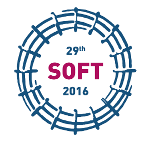Speaker
Jae-young Jang
(Department of Nuclear Engineering)
Description
Optical emission spectroscopy with inversion process is used to obtain local emission spectrum from line integrated spectra. Tomographic inversion techniques are widely used with complicated noise reduction and sufficient viewing line of sights. On the other hand, optical probe has advantage of direct measurement although it may lead to plasma perturbation. An optical probe with outer diameter of 13 mm is developed and installed in VEST (Versatile Experiment Spherical Torus) to measure local emission spectrum, which can be used for one-dimensional radial profiles of impurity emission intensities and ion temperatures via shot-to-shot measurements at various radial positions. In the optical probe system, collimated light is collected and transmitted to the spectrometer with ICCD (Intensified Charge Coupled Device) via vacuum feed-through. In initial measurements of ohmic plasmas in VEST, radial emission profile of H alpha line (656 nm) shows hollow shape while OV line (650 nm) shows centrally peaked shape. However, plasma current decreases by 10 % when the optical probe is inserted up to the plasma center. Modified optical probe is under development to reduce plasma perturbation.
Co-authors
Jae-young Jang
(Department of Nuclear Engineering, Seoul National University, Seoul, South Korea)
Y. S. Hwang
(Department of Nuclear Engineering, Seoul National University, Seoul, South Korea;Center for Advanced Research in Fusion Reactor Engineering, Seoul National University, Seoul, South Korea)
YooSung Kim
(Department of Nuclear Engineering, Seoul National University, Seoul, South Korea)

